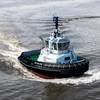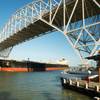Military Sealift Command (MSC) advanced auxiliary dry cargo/ammunition ship USNS Alan Shepard (T-AKE 3) slides backwards into San Diego Bay during a christening ceremony held at the National Steel and Shipbuilding Company (NASSCO). The Shepard is the third Lewis and Clark class supply ship to be launched and is scheduled to join the fleet next summer. U.S. Navy photo by Mass Communication Specialist 3rd Class Patrick M. Kearney
The Navy christened USNS Alan Shepard (T-AKE 3), the newest ship in the Lewis and Clark class of underway replenishment ships Dec. 6, during a launching at General Dynamics National Steel and Shipbuilding Company (NASSCO), San Diego.
The ship honors the first American in space, Rear Adm. Alan B. Shepard Jr. Like the legendary explorers, Meriwether Lewis and William Clark, for whom the first ship of the class was named, Shepard bravely volunteered to explore the unknown and became the first American in space. Thus began one of the most challenging endeavors in human history: the manned exploration of space.
Shepard graduated from the U.S. Naval Academy in Annapolis, Md., in 1944. He served aboard destroyers in the Pacific during World War II and later entered flight training, receiving his designation as a naval aviator in 1947. Shepard served several tours in fleet squadrons and was selected to attend the Navy Test Pilot School in 1950. He logged more than 8,000 hours of flying time.
In 1959, Shepard was one of seven men chosen by NASA for the Mercury manned space flight program. Two years later, he became the first American to journey into space in the Freedom 7 spacecraft launched by a Redstone rocket on a suborbital flight. He reached an altitude of 116 miles.
In 1963, he was designated chief of the Astronaut Office with responsibility for monitoring the coordination, scheduling and control of all activities involving NASA astronauts. Shepard made his second space flight as spacecraft commander on Apollo 14 in 1971. He was accompanied on the third U.S. lunar landing mission by Stuart A. Roosa, command module pilot, and Edgar D. Mitchell, lunar module pilot. Shepard logged 216 hours and 57 minutes in space, of which 9 hours and 17 minutes were spent in lunar surface extravehicular activity. He resumed his duties as chief of the Astronaut Office in June 1971 and served in this capacity until he retired from NASA and the Navy Aug. 1, 1974.
After his Navy and NASA careers, he entered private business in Houston and served as the president of the Mercury Seven Foundation, a non-profit organization now known as the Astronaut Scholarship Foundation that provides college science scholarships for deserving students. Shepard died July 21, 1998, at the age of 74.
John H. Sununu, former governor of New Hampshire, delivered the ceremony's principal address. Laura Churchley served as sponsor of the ship named for her father. The launching ceremony was highlighted in the time-honored Navy tradition when the sponsor breaks a bottle of champagne across the bow to formally christen the ship "Alan Shepard."
Alan Shepard is the third ship in the Navy's new 11-ship T-AKE 1 class. T-AKE is a combat logistics force vessel replacing the T-AE 26 Kilauea-class ammunition ships, T-AFS 1 Mars-class combat stores ships, and when operating with T-AO 187 Henry J. Kaiser-class oiler ships, the AOE 1 Sacramento-class fast combat support ships. The ship design supports two military logistics helicopters to conduct vertical replenishment.
Designed to operate independently for extended periods at sea while providing replenishment services to U.S., NATO and allied ships, Alan Shepard will directly contribute to the ability of the Navy to maintain a worldwide forward presence. Ships such as Alan Shepard provide logistic lift from sources of supply either in port or at sea from specially equipped merchant ships. The ship will transfer cargo (ammunition, food, limited quantities of fuel, repair parts, ship store items, and expendable supplies and material) to ships and other naval warfare forces at sea.
Alan Shepard is 689 feet in length, has an overall beam of 106 feet, a navigational draft of 30 feet, and displaces approximately 42,000 tons. Powered by a single-shaft diesel-electric propulsion system, the ship can reach a speed of 20 knots. As part of the Naval Fleet Auxiliary Force, the ship will be designated USNS. The term stands for United States Naval Ship. Unlike their United States Ship (USS) counterparts, USNS vessels are manned primarily by civil service and civilian mariners working for the U.S. Navy Military Sealift Command, Washington, D.C.
Subscribe for
Maritime Reporter E-News
Maritime Reporter E-News is the maritime industry's largest circulation and most authoritative ENews Service, delivered to your Email five times per week










